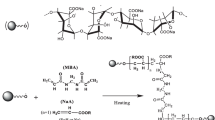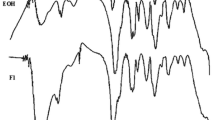Abstract
The present study aims to create a controlled release system through the preparation and characterization of hydrogels based on 2-hydroxyl ethyl methacrylate (HEMA). In order to investigate the influence of photo-initiators on the drug release behavior of the resulting hydrogels, three different photo-initiators [2,2-dimethoxy-2-phenyl-acetophenone] (Irgacure 651), 1-hydroxycyclohexyl phenyl ketone (Irgacure 184) and 2-hydroxy-4′-(2-hydroxyethoxy)-2-methylpropiophenone (Irgacure 2959) were used. In addition, hydroxyapatite (HAp) was employed to modify HEMA hydrogels. The synthesis of hydrogels was confirmed by characterization through Fourier transform infrared spectroscopy, nuclear magnetic resonance (13C NMR) spectroscopy and digital microscope. The responsive behaviors were investigated by recording swelling ratios under different conditions. In vitro drug release studies were performed for donepezil hydrochloride-loaded hydrogels at pH 1.2, 6.8 and 7.4. The results indicated that hydrogels synthesized using Irgacure 2959 released the maximum amount of donepezil hydrochloride. Moreover, the release rate decreased in the presence of HAp.








Similar content being viewed by others
References
Lee EL, Giovanello KS, Saykin AJ et al (2017) Single-nucleotide polymorphisms are associated with cognitive decline at Alzheimer’s disease conversion within mild cognitive impairment patients. Alzheimer’s Dement Diagn Asses Dis Monitor 8:86–95
Gibbs RB, Mauk R, Nelson D, Johson DA (2009) Donepezil treatment restores the ability of estradiol to enhance cognitive performance in aged rats: evidence for the cholinergic basis of the critical period hypothesis. Horm Behav 56:73–83
Choi J, Choi MK, Chong S, Chung SJ, Shim CK, Kim DD (2012) Effect of fatty acids on the transdermal delivery of donepezil: in vitro and in vivo evaluation. Int J Pharm 422:83–90
Xia Z, Zhang R, Wu P, Xia Z, Hu Y (2012) Memory defect induced by beta-amyloid plus glutamate receptor agonist is alleviated by catalpol and donepezil through different mechanisms. Brain Res 1441:27–37
Saluja S, Kasha PC, Paturi J, Anderson C, Morris R, Banga AK (2013) A novel electronic skin patch for delivery and pharmacokinetic evaluation of donepezil following transdermal iontophoresis. Int J Pharm 453:395–399
Kelly BJ, Petersen RC (2007) Alzheimer disease and mild cognitive impairment. Neural Clin 25:577–609
Potyk D (2005) Treatments for Alzheimer disease. South Med J 98:628–635
Neufeld L, Bianco-Peled H (2017) Pectin–chitosan physical hydrogels as potential drug delivery vehicles. Int J Biol Macromol 101:852–861
Wang Y, Chen L, Li Tan, Zhoo Q, Luo F, Wei Y, Qian Z (2014) PEG-PCL based micelle hydrogels as oral docetaxel delivery systems for breast cancer therapy. Biomaterials 35:6972–6985
Berkovitch Y, Yelin D, Seliktar D (2015) Photo-patterning PEG-based hydrogels for neuronal engineering. Eur Polym J 72:473–483
Verma SK, Pandey VS, Yaday M, Behari K (2014) Grafting of N-(hydroxymethyl) acrylamide on to k-carrageenan: synthesis, characterization and applications. Carbohydr Polym 102:590–597
Liu DE, Dursch TJ, Taylor NO, Chan SY, Bregante DT, Radke CJ (2016) Diffusion of water-soluble sorptive drugs in HEMA/MAA hydrogels. J Controll Release 239:242–248
Barron V, Killion JA, Pilkington L, Burke G, Geever LM, Lyons JG, McCullagh E, Higginbotham CL (2015) Development of chemically cross-linked hydrophilic–hydrophobic hydrogels for drug delivery applications. Eur Polym J 75:25–35
Bounabi L, Moknachi NB, Haddadine N, Ouazib F, Barille R (2016) Development of poly(2-hydroxyethyl methacrylate)/clay composites as drug delivery systems of paracetamol. J Drug Deliv Sci Technol 33:58–65
Khoee S, Kardani M (2014) Preparation of PCL/PEG superporous hydrogel containing drug-loaded nanoparticles: the effect of hydrophobic–hydrophilic interface on the physical properties. Eur Polym J 58:180–190
Wong RSH, Ashton M, Dodou K (2015) Effect of crosslinking agent concentration on the properties of unmedicated hydrogels. Pharmaceutics 7:305–319
Yom-Tov O, Seliktar D, Bianco-Peled H (2016) PEG-Thiol based hydrogels with controllable properties. Eur Polym J 74:1–12
Yin W, Su R, Qi W, He Z (2012) A casein-polysaccharide hybrid hydrogel cross-linked by transglutaminase for drug delivery. J Mater Sci 47:2045–2055. https://doi.org/10.1007/s10853-011-6005-7
Hu Y, Dong X, Ke L, Zhang S, Zhao D, Chen H, Xiao X (2017) Polysaccharides/mesoporous silica nanoparticles hybrid composite hydrogel beads for sustained drug delivery. J Mater Sci 52:3095–3109. https://doi.org/10.1007/s10853-016-0597-x
Almeida JF, Ferreira P, Lopes A, Gil MH (2011) Photocrosslinkable biodegradable responsive hydrogels as drug delivery systems. Int J Biol Macromol 49:948–954
Lu S, Anseth SK (1999) Photopolymerization of multilaminated poly(HEMA) hydrogels for controlled release. J Controll Release 57:291–300
Zhang H, Niu Q, Wang N, Nie J, Ma G (2015) Thermo-sensitive drug controlled release PLA core/PNIPAM shell fibers fabricated using a combination of electrospinning and UV photo-polymerization. Eur Polym J 71:440–450
Wang T, Mu X, Li H, Wu W, Nie J, Yang D (2013) The photocrosslinkable tissue adhesive based on copolymeric dextran/HEMA. Carbohydr Polym 92:1423–1431
Dixit A, Bag DS, Kalra SJS (2017) Synthesis of strong and stretchable double network (DN) hydrogels of PVA-borax and P(AM-co-HEMA) and study of their swelling kinetics and mechanical properties. Polymer 119:263–273
Tang Y, Du Y, Li Y, Wang X, Hu X (2008) A thermosensitive chitosan/poly(vinyl alcohol) hydrogel containing hydroxyapatite for protein delivery. J Biomed Mater Res Part A 91(4):953–963
Lin G, Tarasevich B (2013) Photopolymerized hydrogel composites from poly(ethylene glycol) and hydroxyapatite for controlled protein delivery in vitro. J Appl Polym Sci 128:3534–3539
Killion JA, Geever LM, Devine DM, Higginbotham CL (2014) Fabrication and in vitro biological evaluation of photopolymerisable hydroxyapatite hydrogel composites for bone regeneration. J Biomater Appl 28:1274–1283
Gaharwar AK, Dammu SA, Canter JM, Wu CJ, Schmidt G (2011) Highly extensible, tough, and elastomeric nanocomposite hydrogels from poly(ethylene glycol) and hydroxyapatite nanoparticles. Biomacromolecules 12:1641–1650
Lakka NS, Goswami N (2012) Solubility and dissolution profile studies of gliclazide in pharmaceutical formulations by HPLC. Int Res J Pharm 3(6):126–129
Ferreira L, Vidal MM, Gil MH (2000) Evaluation of poly(2-hydroxyethyl methacrylate) gels as drug delivery systems at different pH values. Int J Pharm 194:169–180
Pereira DR, Canadas RF, Silva-Correia J, Marques AP, Reis RL, Oliveira JM (2014) Gellan gum-based hydrogel bilayered scaffolds for osteochondral tissue engineering. Key Eng Mater 587:255–260
Oliveira JM, Rodrigues SS, Malafaya SPB, Gomes ME, Viegas CA (2006) Novel hydroxyapatite/chitosan bilayered scaffold for osteochondral tissue-engineering applications: scaffold DESIGN and its performance when seeded with goat bone marrow stromal cells. Biomaterials 27:6123–6137
Fujita K, Nishiyama N (2006) 13C NMR analysis of the etching efficacy of acidic monomers in self-etching primers. J Dent 34:123–133
Park J, Ye Q, Spencer P, Laurence JS (2012) Determination of neutralization capacity and stability of a basic methacrylate monomer using NMR. Int J Polym Mater 61(2):144–153
Gupta A, Prasad A, Mulchandan N, Shah M, Sankar MR, Kumar S, Katiyar V (2017) Multifunctional nanohydroxyapatite-promoted toughened high-molecular-weight stereocomplex poly(lactic)acid- based bionanocomposite for both 3D-printed orthopedic implants and high-temperature engineering applications. ACS OMEGA 2:4039–4052
Boonsongrit Y, Abe H, Sato K, Naito M, Yoshimura M, Ichikawa H, Fukumori Y (2008) Controlled release of bovine serum albumin from hydroxyapatite microspheres for protein delivery system. Mater Sci Eng B 148:162–165
Acknowledgements
This work was supported by Research Fund of the Yildiz Technical University. Project Number: FDK-2017-3029.
Author information
Authors and Affiliations
Corresponding author
Rights and permissions
About this article
Cite this article
Senol, S., Akyol, E. Synthesis and characterization of hydrogels based on poly(2-hydroxyethyl methacrylate) for drug delivery under UV irradiation. J Mater Sci 53, 14953–14963 (2018). https://doi.org/10.1007/s10853-018-2713-6
Received:
Accepted:
Published:
Issue Date:
DOI: https://doi.org/10.1007/s10853-018-2713-6




